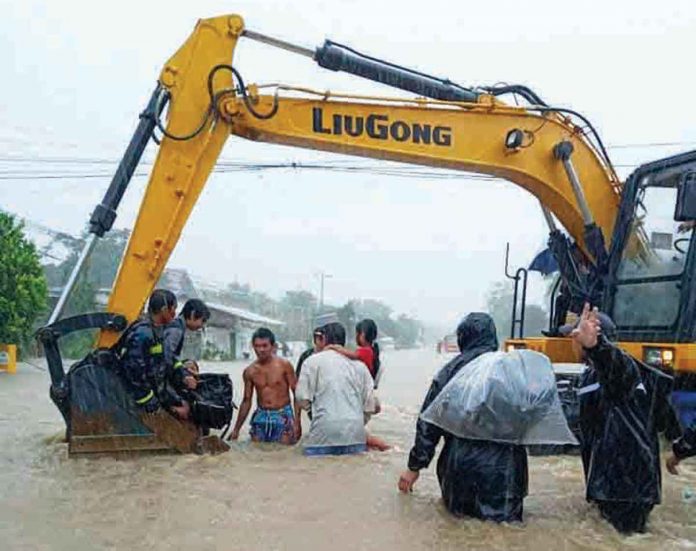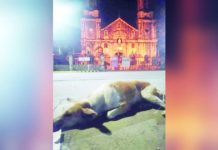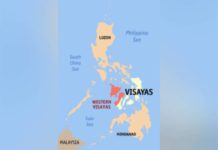
ILOILO – The northern municipality of Sara declared a state of calamity. Torrential rains flooded 34 barangays while landslides hit eight others.
The declaration will allow the municipal government to use its calamity fund for disaster response and relief efforts, according to Mayor Jon Aying.
Rising floodwaters and landslides forced 1,699 families (6,043 individuals) to leave their houses and seek shelter in evacuation centers.
The Sangguniang Bayan (SB) of Sara convened on Tuesday morning to declare the state of calamity.
“The flood not only destroyed houses. It also inundated our agricultural crops,” Aying told Panay News.
The mayor also confirmed one casualty – 62-year-old Florentino Dema-ala of Barangay Ardemil.
Dema-ala was swept away by raging floodwaters on Monday afternoon.
Aying said another resident went missing – a 16-year-old lad of Barangay Apologista. As of press time, a search and rescue operation was ongoing.
Sara, 98 kilometers north of Iloilo City, has a population of 54,637 people, the 2020 census showed.
The National Disaster Risk Reduction and Management Council’s (NDRRMC) Memorandum Order No. 60, Series of 2019 set the criteria for the declaration of a state of calamity. These were the following:
a) at least 15 percent of the forecasted affected population based on science-based projection are in need of emergency assistance;
b) at least 30 percent of the means of livelihood on agricultural, business and industrial sectors are affected;
c) damage to critical and lifeline infrastructure/facilities such as major roads and bridges, power stations, potable water supply systems, and telecommunication facilities;
d) widespread destruction of fishponds, crops, poultry and livestock
e) disruption of lifeline such as food chain, electricity, potable water system, other transport systems, communication system, access to health service, and other related systems that cannot be restored with one week, or in the case for highly-urbanized areas where restoration of the above lifelines cannot be done within twenty-four hours.
g) significant degradation to environment and natural resources based on the recommendations of government agencies
MORE MAY FOLLOW SARA’S MOVE
According to Dr. Jerry Bionat, head of the Provincial Disaster Risk Reduction and Management Office (PDDRMO), the local governments of Ajuy and Passi City were poised to follow Sara’s move to declare a state of calamity.
“Si Major Jett (of Ajuy) nag-communicate na sa aton,” he said.
PDRRMO data showed 29 of Ajuy’s 34 barangays got flooded, resulting to the displacement of 6,889 families (15,863 individuals).
According to the 2020 census, Ajuy — located in northern Iloilo just like Sara – has a population of 53,462 people.
Mayor Stephen Palmares of Passi City also indicated interest in a similar declaration. A total of 1,270 families (5,028 individuals) moved to evacuation centers to avoid being trapped in their homes by floodwaters, he said.
Passi City is subdivided into 51 barangays.
Bionat said the provincial government itself may also declare a state of calamity. They are just waiting for data from various local government units.
Iloilo province is made up of 42 towns and the component city of Passi.
As of 2 p.m. on Tuesday, 16 towns have so far submitted initial reports to the PDRRMO – Leganes, New Lucena, Pototan, Dingle, Dueñas, Dumangas, San Enrique, Banate, Ajuy, Balasan, Barotac Viejo, Carles, Lemery, Sara, San Dionisio, and San Rafael.
These towns have a combined 20,714 flood-displaced families (74,707 individuals). Here’s the breakdown:
* Leganes – one family composed of seven individuals
* New Lucena – 21 families composed of 105 individuals
* Pototan – 508 families composed of 2,234 individuals
* Dingle – 1,089 families composed of 5,444 individuals
* Dueñas – 100 families composed of 500 individuals
* Dumangas – 1,593 families composed of 7,965 individuals
* San Enrique – 47 families composed of 218 individuals
* Banate – 2,861 families composed of 10,749 individuals
* Ajuy – 6,889 families composed of 15,749 individuals
* Balasan – 2,090 families composed of 8,139 individuals
* Barotac Viejo – 2,090 families composed of 8,139 individuals
* Carles – 135 families composed of 338 individuals
* Lemery – 338 families composed of 1,304 individuals
* Sara – 1,699 families composed of 6,043 individuals
* San Dionisio – 1,461 families composed of 7,305 individuals
* San Rafael – 1,584 families composed of 7,614 individuals/PN



